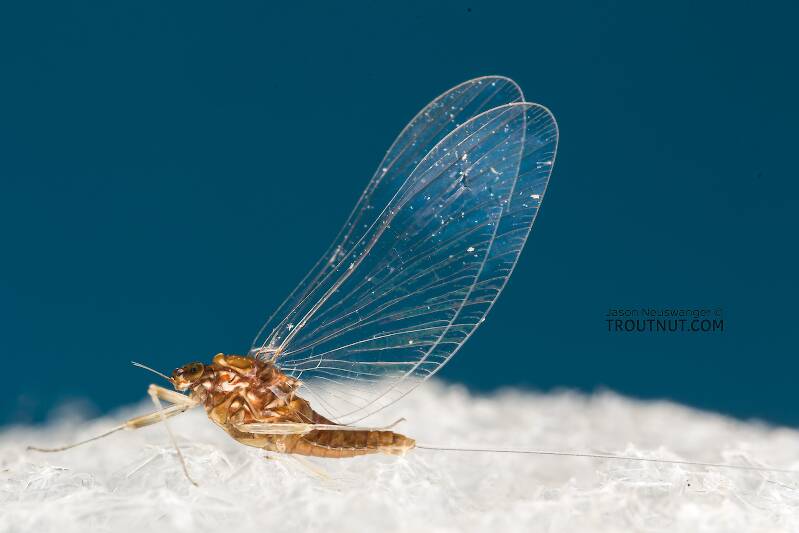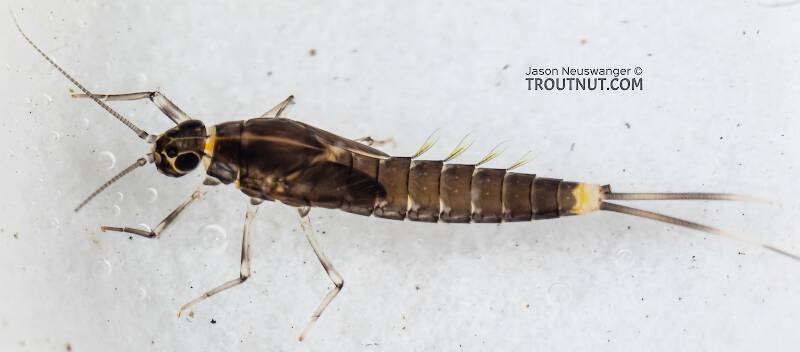
Hex Mayflies
Hexagenia limbata
The famous nocturnal Hex hatch of the Midwest (and a few other lucky locations) stirs to the surface mythically large brown trout that only touch streamers for the rest of the year.
Featured on the forum


Troutnut is a project started in 2003 by salmonid ecologist Jason "Troutnut" Neuswanger to help anglers and
fly tyers unabashedly embrace the entomological side of the sport. Learn more about Troutnut or
support the project for an enhanced experience here.
Little Western Iron-blue Quills
Like most common names,"Little Western Iron-blue Quill" can refer to more than one taxon. They're previewed below, along with 2 specimens. For more detail click through to the scientific names.
Mayfly Species Acentrella turbida
These are often called Little Western Iron-blue Quills.
Although these mayflies are tiny, in places their numbers compensate for their small size and make for excellent hatches.
Rick Hafele and Dave Hughes in Western Mayfly Hatches rate turbida as one of the three most "key" western species of Baetidae, alongside Baetis tricaudatus and Diphetor hageni. In the West, turbida is more variable in size and appearance than its eastern iteration, in keeping with the large and varied regions it inhabits. It can run as small as 3.5 mm and as large as 5 mm, the larger sizes tending to be more brownish. It is often confused with the smaller broods of Diphetor hageni, but its conical mesonotal projection, lack of hind-wings, exaggerated turbinate eyes (hence its name) and stockier build help to differentiate it.
They are often found on the water with a mix of other Baetidae mayflies, making for very challenging fishing.
Rick Hafele and Dave Hughes in Western Mayfly Hatches rate turbida as one of the three most "key" western species of Baetidae, alongside Baetis tricaudatus and Diphetor hageni. In the West, turbida is more variable in size and appearance than its eastern iteration, in keeping with the large and varied regions it inhabits. It can run as small as 3.5 mm and as large as 5 mm, the larger sizes tending to be more brownish. It is often confused with the smaller broods of Diphetor hageni, but its conical mesonotal projection, lack of hind-wings, exaggerated turbinate eyes (hence its name) and stockier build help to differentiate it.
They are often found on the water with a mix of other Baetidae mayflies, making for very challenging fishing.
See 3 more specimens...
Mayfly Species Labiobaetis propinquus
These are sometimes called Little Western Iron-blue Quills.
This species was previously known as Baetis propinquus, a name from older nomenclatures and angling literature familiar to many western anglers. Prior to its current listing, it did a brief stint in the genus Pseudocloeon. The irony is that though this species has hind wings, it was the last species remaining in Pseudocloeon (before the genus recent Nearctic taxonomic demise) which was best known for its species lacking hind wings as an identifying character.
Though it has a national distribution its most important hatches occur in the West, usually hatching between the larger broods of Baetis tricaudatus. Western anglers experiencing a hatch can easily confuse them with the larger Baetis bicaudatus as both nymphs appear similar with only two tails. Besides size, the adults can be separated from bicaudatus (with the help of a little magnification) because L. propinquus lacks acute costal projections on its tiny hind wings. Conversely, the presence of hind wings and lack of conical mesonotal projections makes them easy to tell from the more common and equally tiny Acentrella turbida.
Though it has a national distribution its most important hatches occur in the West, usually hatching between the larger broods of Baetis tricaudatus. Western anglers experiencing a hatch can easily confuse them with the larger Baetis bicaudatus as both nymphs appear similar with only two tails. Besides size, the adults can be separated from bicaudatus (with the help of a little magnification) because L. propinquus lacks acute costal projections on its tiny hind wings. Conversely, the presence of hind wings and lack of conical mesonotal projections makes them easy to tell from the more common and equally tiny Acentrella turbida.
Mayfly Species Diphetor hageni
These are very rarely called Little Western Iron-blue Quills.
This is one of the most important species of the Baetidae family. It is distributed across the country but most of its fame comes from excellent hatches in the West. Prior to many other former species being combined with Baetis tricaudatus, most angling literature considered it the most populous and widespread western species of the Baetidae family.
References
- Hafele, Rick and Hughes, Dave. 2004. Western Mayfly Hatches. Frank Amato Publications.



